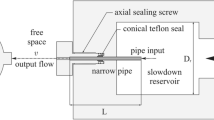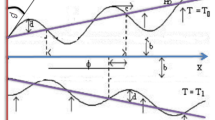Abstract
IN the course of an extensive investigation (with Prof. A. C. Burton at the University of Western Ontario) of the hæmodynamics of perfused vascular beds, it was found necessary to examine the somewhat simpler case of blood flow in narrow glass tubes. Accordingly, the pressure-flow curves in tubes of radii 50–750µ for human erythrocytes suspended in standard acid–citrate–dextrose were measured at 25.5° C. over a wide range of hæmatocrits1–4. A typical set of such pressure-flow curves is shown in Fig. 1. The curves were found to approach linearity at moderate flow rates; if the linear segments are extrapolated back, they intersect the positive pressure axis at finite values and then converge to a common ‘nodal point’ on the negative flow axis. However, in the non-linear region at very low flow rates, the curves appear to converge toward the origin. There is no evidence of any yield stress or intercept on the positive pressure axis. All the curves can be represented by an equation of the form:  where Q̇ is the volume rate of flow and P the pressure gradient; the parameters M and k depend on both tube radius and hæmatocrit, whereas the nodal point B depends only on the tube radius3. Pressure-flow curves of similar shape have been obtained by other workers and can be inferred from the apparent viscosity data of Kümin5.
where Q̇ is the volume rate of flow and P the pressure gradient; the parameters M and k depend on both tube radius and hæmatocrit, whereas the nodal point B depends only on the tube radius3. Pressure-flow curves of similar shape have been obtained by other workers and can be inferred from the apparent viscosity data of Kümin5.
This is a preview of subscription content, access via your institution
Access options
Subscribe to this journal
Receive 51 print issues and online access
$199.00 per year
only $3.90 per issue
Buy this article
- Purchase on Springer Link
- Instant access to full article PDF
Prices may be subject to local taxes which are calculated during checkout
Similar content being viewed by others
References
Haynes, R. H., Canad. Biol., 15, 255 (1956).
Haynes, R. H., and Burton, A. C., “Proceedings of the First National Biophysics Conference”, ed. by Quastler, H., and Morowitz, H. J., 452 (Yale University Press, 1959).
Haynes, R. H., and Burton, A. C., Amer. J. Physiol., 197 (5), 943 (1959).
Haynes, R. H., “The Rheology of Blood”, doctoral dissertation (University of Western Ontario, London, Canada, 1957).
Kümin, K., Inaugural Dissertation, Universität Bern (Paulusdruckerei, Freiburg in der Schweiz, 1949).
Dix, F. J., and Scott Blair, G. W., J. App. Phys., 11, 574 (1950).
Taylor, M. G., Phys. Biol. Med., 3, 273 (1959).
Taylor, M. G., Aust. J. Exp. Biol. Med. Sci., 33, 1 (1955).
Scott Blair, G. W., Nature, 183, 613 (1959).
Reiner, M., and Scott Blair, G. W., Nature, 184, 354 (1959).
Casson, N., “The Rheology of Disperse Systems”, ed. by Mill, C. C., Chap. 5 (Pergamon Press, London, 1959).
Author information
Authors and Affiliations
Rights and permissions
About this article
Cite this article
HAYNES, R. Blood Flow through Narrow Tubes. Nature 185, 679–681 (1960). https://doi.org/10.1038/185679a0
Issue Date:
DOI: https://doi.org/10.1038/185679a0
This article is cited by
-
Flow of Blood through Narrow Tubes
Nature (1960)
Comments
By submitting a comment you agree to abide by our Terms and Community Guidelines. If you find something abusive or that does not comply with our terms or guidelines please flag it as inappropriate.



